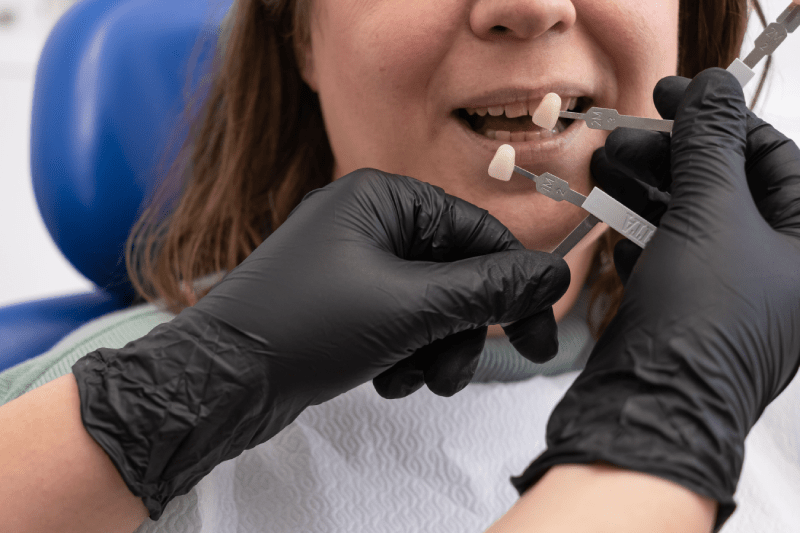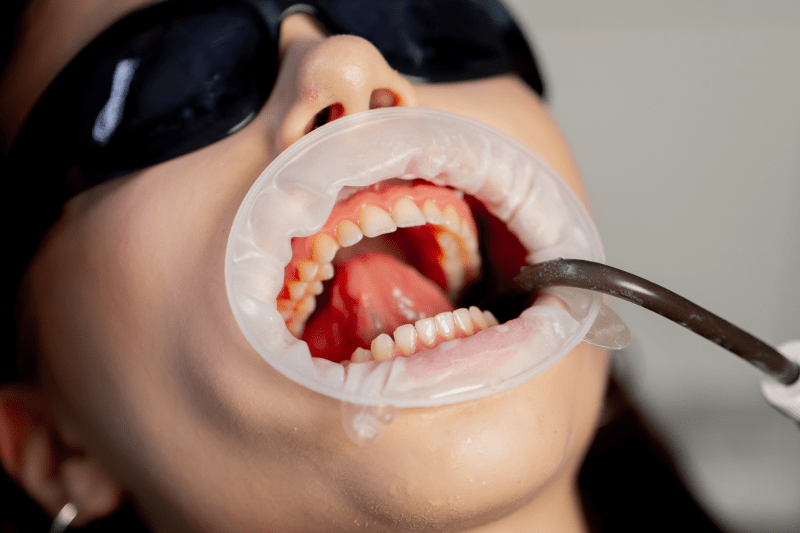Teeth Bonding vs Veneers: Pros and Cons
In the field of cosmetic dentistry, the two most popular options for transforming your smile are Teeth Bonding and Veneer treatments. Both methods aim to improve the appearance of your teeth, but there are significant differences between them. This content aims to help you make the right decision by explaining the fundamental differences, pros, and cons of these two treatments. For more information and a personalized treatment plan, you can contact Cure Holiday.
What is Bonding and How is it Applied?
Bonding is a composite resin material used to fix minor imperfections, chips, or gaps in the teeth. During this procedure, the dentist uses a special light to bond the resin to the tooth and shape it. The treatment is usually completed in a single session with minimal intervention to the tooth’s natural structure. This is a minimalist approach that preserves the tooth and provides aesthetic results.
What are Veneers and How are They Applied?
Veneers are thin porcelain or composite layers that are bonded to the front surface of the teeth. These coverings are used to permanently change the color, shape, size, and alignment of the teeth. Porcelain veneers are custom-made for the patient in a lab, while composite veneers can be applied directly in the clinic. The treatment process usually takes several sessions and involves removing a very small amount of enamel from the tooth’s surface to make room for the veneer.
What Are the Key Differences?
The most fundamental differences between bonding and veneers are the treatment process, the materials used, and the application method. Bonding is a less invasive solution that focuses on minor imperfections and can be completed in a single session. Veneers, on the other hand, cover the entire front surface of the tooth, making more significant aesthetic changes and offering longer-lasting results. Your dentist will recommend the most suitable option for you based on your needs.

What Are the Pros and Cons of Bonding?
The biggest advantages of bonding are that it is cost-effective and can be completed in a single session. Also, since there is minimal intervention to the natural tooth structure, the procedure is reversible. The disadvantage is that it is less durable than porcelain veneers and more prone to staining over time. The average lifespan is 5-7 years, and it may require regular maintenance.
What Are the Pros and Cons of Veneers?
The advantages of veneers are their natural appearance, high stain resistance, and longevity. Porcelain veneers reflect light like natural tooth enamel and can last for 10-15 years or more with proper care. Their disadvantages are that they are more expensive and the procedure is irreversible because some of the tooth enamel needs to be removed.
For Which Conditions is Bonding More Suitable?
Bonding is an ideal option when you want to correct minor gaps, small chips, or slight color differences in your teeth. You can also choose bonding if you are looking for a quick and budget-friendly solution for a subtle aesthetic touch. It is a less invasive procedure that prioritizes your dental health.
For Which Conditions are Veneers More Suitable?
Veneers are a more suitable option when you want to make more comprehensive aesthetic changes to your teeth, for example, to completely change the color, shape, or size of your teeth. For significant discoloration, large gaps, or mild misalignment, veneers provide a permanent and natural result.
How Different Are the Treatment Durations?
A bonding procedure can typically be completed in a single dental appointment, while veneer treatment takes longer. The preparation of porcelain veneers is done in a lab, which can take several weeks. During this time, the patient is fitted with temporary veneers. Composite veneers can usually be applied in one session, making the process faster.
Which Offers a More Natural Look?
Both bonding and veneers have the potential to offer a natural look, but porcelain veneers are generally superior in this regard. Porcelain reflects light like natural tooth enamel, providing the most successful aesthetic results. While bonding materials can also look natural, they may lose their shine over time.
Is There Pain or Sensitivity?
Anesthesia is generally not needed for a bonding procedure, and it is a painless process. For veneer treatment, a local anesthetic may be applied since some tooth enamel is removed. After the treatment, mild sensitivity that lasts for a few days is considered normal.
What is Their Lifespan?
The lifespan of a bonding application is around 5-7 years, depending on the patient’s oral hygiene and habits. Porcelain veneers are much more durable and can last for 10-15 years or more with proper care. Composite veneers have a shorter lifespan than porcelain.
Are the Treatments Reversible?
The Bonding treatment is reversible because minimal tooth enamel is removed, and it can be easily taken off. In a Veneer treatment, a portion of the tooth enamel is permanently removed, so the procedure is irreversible. Therefore, it is important to discuss all the details with your dentist before deciding on veneer treatment.
Which Treatment is Better for Crooked Teeth?
For minor crookedness, veneers can be a good solution, but for more serious alignment issues, orthodontic treatments like Invisalign are more suitable. Veneers improve the appearance of teeth but do not physically move them. Your dentist should decide which treatment is more appropriate for you.
Which is More Suitable for Gaps Between Teeth?
For small gaps between teeth, both bonding and veneers can be suitable. Bonding offers a quick and effective solution for closing small gaps. However, for wider gaps or when multiple teeth need aesthetic improvement, veneers provide a more permanent and comprehensive solution.
How is Pricing Determined?
Pricing varies depending on the type of material used, the number of teeth being treated, and the dentist’s experience. Bonding is more economical than veneers because the material cost and application time are shorter. Porcelain veneers are more expensive due to the lab process and the use of higher-quality materials.

What Happens After Smoking or Coffee Consumption?
Porcelain veneers are highly resistant to staining from substances like coffee and cigarettes and maintain their color for a long time. Composite bonding is also stain-resistant, but color changes can be observed over time. Therefore, regular maintenance and hygiene are important.
Does Gum Health Affect the Treatments?
Healthy gums are essential for both bonding and veneer treatments. In patients with gum disease, gum health must be restored before these treatments can be applied. Healthy gums are crucial for the success and longevity of the treatment.
What Materials are Used?
Veneers are typically made from porcelain (E-max, Zirconium) or composite resin materials. In bonding treatment, only composite resin is used. Each material has its own aesthetic, durability, and cost advantages. Your dentist will recommend the most suitable material for you based on your expectations and budget.
Are Teeth Filed Down for Treatment?
In a Bonding procedure, the teeth are almost never filed down or only slightly roughened. In a Veneer treatment, a very thin layer of tooth enamel is removed to allow the veneer to fit perfectly and provide a natural look. This amount is usually around 0.5-0.8 mm.
How Should I Care for My Teeth After Treatment?
Both bonding and veneers require the same regular care as your natural teeth. Brushing twice a day, flossing, and regular dental check-ups are essential to extend the lifespan of the treatments. It is also important to avoid biting hard foods and to use a night guard if you have a teeth-grinding habit.
When Are the Results of the Treatment Visible?
The results of a Bonding treatment are usually noticeable immediately. For a Veneer treatment, once the permanent veneers arrive from the lab, your new smile will be revealed within a few days. Both treatments provide a quick and effective transformation of the patient’s smile.
Which Treatment Has a Longer Lifespan?
Generally, porcelain veneers are the most long-lasting option. Due to its durability and stain-resistant nature, porcelain can last for 10-15 years or more with proper care. Composite bonding and composite veneers have a lifespan of around 5-7 years and may need to be replaced more frequently.
Which is Better for a Single Tooth?
If a single tooth has a minor imperfection (a small chip, crack, or stain), bonding offers a less invasive, quicker, and more economical solution. However, if the tooth has more significant damage or a deep-seated color issue, a veneer or a crown can be a more permanent and aesthetic solution.
Which is Better for Multiple Teeth?
When aesthetic changes need to be made to multiple teeth, veneers offer a more comprehensive result. The dentist can create a design that ensures all the teeth are in harmony. This provides a balanced and aesthetic outcome for your entire smile.
Am I a Suitable Candidate for Bonding?
If your teeth do not have severe decay, gum disease, or extreme crookedness, you may be a suitable candidate for bonding. Bonding is ideal for those who want to fix minor aesthetic issues and refresh their smile. A dental examination is the best way to determine the most suitable treatment for you.
Am I a Suitable Candidate for Veneers?
The best candidates for veneers are individuals with healthy teeth and gums who have issues with the shape, color, or minor alignment of their teeth. Veneers are also a good option for those seeking a permanent and long-lasting smile transformation.
What is the Difference Between Porcelain and Composite Veneers?
Porcelain veneers are made in a lab, are more durable, and are stain-resistant. Composite veneers can be applied in the clinic in a single session, are cheaper, but are not as durable and long-lasting as porcelain. Your aesthetic expectations and budget will be the deciding factors in this choice.
Does a Teeth-Grinding Habit Affect the Treatments?
Yes, a teeth-grinding habit (bruxism) can damage both bonding and veneers. If you have this habit, your dentist might recommend a night guard. This precaution is important to extend the lifespan of the treatments and reduce the risk of chipping.
Can Veneers be Done After Gum Recession?
Before veneers are applied to areas with gum recession, gum health must be restored. Veneers cannot be bonded directly to the gums and require a healthy foundation. Gum recession can cause the edges of the veneers to become visible, so a careful evaluation is necessary.
Which Method is Better for Chipped Teeth?
The appropriate treatment for a chipped tooth depends on the size and location of the chip. For a small chip, bonding offers a quick and effective solution. However, for larger chips or damage that weakens the tooth’s structure, a more durable veneer or a full crown might be a better option to provide complete protection.
Does Discoloration Occur After Bonding?
Yes, the composite bonding material can become stained over time from substances like tea, coffee, or cigarettes. Therefore, it is recommended that patients with bonding pay extra attention to their oral hygiene and limit their consumption of staining foods and beverages.
Will My Teeth Be Stronger After Veneers?
Veneers, especially porcelain ones, provide an extra layer of protection to the front surface of the tooth. This helps the tooth become more resistant to impacts and wear. However, in cases where the tooth is structurally weak, a more comprehensive treatment like a crown might be more suitable.
Which Treatment Has a Higher Cost?
In general, porcelain veneers have a higher cost than composite bonding. The durability of porcelain, its natural appearance, and the costs associated with the lab process explain the price difference. Composite bonding is more economical because it is completed in a shorter time and uses less material.
Do I Need to Get a Tooth Extracted for Veneers?
No, tooth extraction is not necessary for veneer treatment. The treatment is applied to the front surface of existing teeth. If you have a missing tooth, other treatments like an implant or a bridge are needed to fill that gap.

Which Treatment Provides Faster Results?
Composite bonding typically provides instant results as it is usually completed in a single clinic visit. For Veneer treatment, especially for porcelain veneers, you may need to wait a few days or weeks due to the lab process. However, both treatments ultimately offer fast and effective aesthetic results.
Which Treatment is Less Aggressive?
Bonding is the least aggressive (minimally invasive) treatment method as it involves almost no changes to the tooth enamel. In a veneer treatment, a very thin layer of tooth enamel is removed to make room for the veneer. Therefore, for those who want to preserve the natural structure of their tooth, bonding might be a better option.
Which Treatment Needs to be Replaced More Frequently?
The lifespan of composite bonding and composite veneers is shorter, so they may need to be replaced more frequently than porcelain veneers. Porcelain veneers, with proper care, can last for many years and do not require frequent replacement.
Can the Two Treatments Be Used Together?
Yes, in some cases, both treatments can be used together. For example, veneers can be used on the front teeth for a major smile makeover, while bonding can be applied to fix minor imperfections on the back teeth. This offers a solution that is both aesthetically pleasing and budget-friendly.
Which Treatment Corrects Tooth Color Best?
Porcelain veneers are the best option for correcting severe discoloration and staining. Due to porcelain’s high opacity and light-reflecting properties, the color of the underlying tooth is completely masked. While bonding can also correct color, it may not be as effective as porcelain for very dark teeth.
Which is Better for Worn Teeth?
Bonding can be used for minor tooth wear. However, if there is more serious wear or weakening of the tooth’s structure, a more protective treatment like a veneer or a crown might be more appropriate.
How Do I Determine the Best Option?
To determine the best option, you should have a detailed consultation with a dentist. Your dentist will evaluate your oral health, expectations, and budget, as well as the pros and cons of both treatments, to provide you with a personalized treatment plan.
For more information about dental bonding and veneer treatments and to create a personalized treatment plan, you can contact Cure Holiday.


